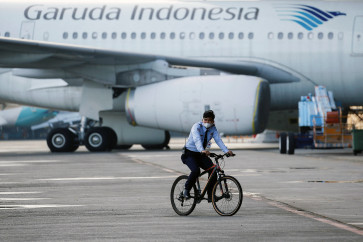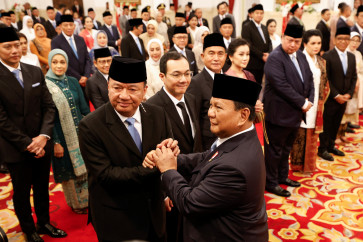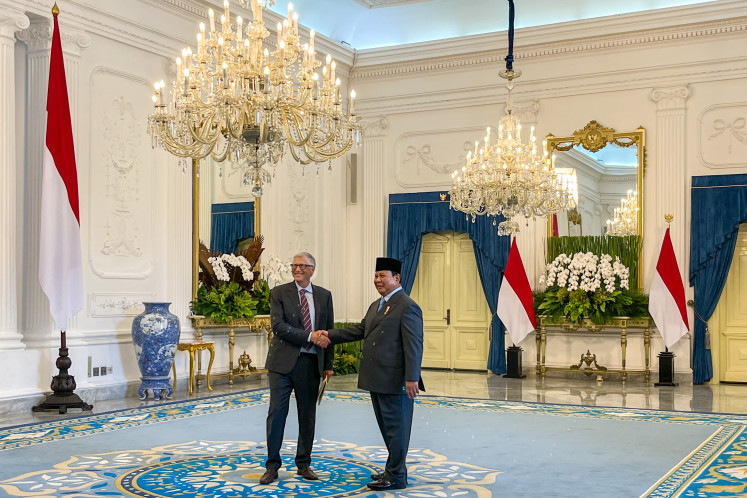Mixed response to lower rate on KUR loans
A decision by the government to reduce the interest rate on subsidized micro credit (KUR) loans to 7 percent in 2018 from 9 percent this year has prompted different reactions
Change text size
Gift Premium Articles
to Anyone

A
decision by the government to reduce the interest rate on subsidized micro credit (KUR) loans to 7 percent in 2018 from 9 percent this year has prompted different reactions.
Coordinating Economic Minister Darmin Nasution announced over the weekend that the decision was made following obstacles encountered by small-time entrepreneurs, especially those working in the manufacturing sector, in obtaining funding for their businesses.
“We must always push for more KUR lending to the manufacturing sector, so that small and medium enterprises [SMEs] can enjoy this low-rate credit program by the government,” Darmin said in a recent statement.
The government plans to allocate Rp 120 trillion (US$8.83 billion) to the program next year, up 12.6 percent from this year’s KUR budget of Rp 106.6 trillion.
Just like this year, 50 percent of the overall funding will go to the agriculture, fisheries and processing services, production services and the construction sector.
To accelerate the disbursement of KUR loans, the fund’s policy committee has also prepared three new KUR schemes for plantations, livestock farms and fisheries. The ministry has established the credit ceiling for these special schemes from Rp 25 million to Rp 500 million.
Meanwhile, state-owned lender Bank Rakyat Indonesia (BRI), the country’s largest KUR distributor, is bracing for the effects of the new rate.
BRI president director Suprajarto stated that the lower rate might cost the bank Rp 700 billion in annual revenue, as indicated by the bank’s simulation prior to the announcement on the new rate.
“The government has not discussed the issue with us until now [...]. We are hoping it will subsidize us more after this rate cut,” Suprajarto said at a press conference.
“Hopefully, it won’t be too scary for us if [the rate is lowered to] 7 percent.”
The lender has mapped out some efficiency measures, such as bringing down operational costs by setting up digital services like BRI Spot and MyBRI to serve KUR customers and other micro debtors.
“The key is to handle small clients more efficiently so that we can [reduce spending on] too many marketers,” Suprajarto said.
As of the third quarter of 2017, BRI has channeled Rp 52.2 trillion of its KUR funds, or 74.4 percent of the bank’s annual target.
Hariyadi Sukamdani, chairman of the Indonesian Employers Association (APINDO), applauded the decision, saying the rate cut would benefit SMEs.
“This lowered rate will further propel SMEs. They will become more competitive in their respective industries thanks to the less costly capital,” Hariyadi told The Jakarta Post over the phone on Sunday.
“This is a positive push toward the growth of the micro sector.”
Moreover, he expressed his view that lenders should not worry, as the new rate would stimulate micro debtors.
“Once debtors earn more profit, they will go to banks to deposit their money.”
Instead of worrying, lenders should focus on monitoring the funds they have channeled to debtors, while nurturing their businesses to avoid problems such as misuse of funds and rising rates of non-performing loans (NPL).
As of September, Office of the Coordinating Economic Minister recorded more than 3 million debtors under the KUR program. Up to Rp 69.7 trillion, or 65.3 percent, of the KUR funds have been distributed from the annual target. Meanwhile, the NPL rate has remained at a manageable 0.14 percent.
So far, micro funding makes up the bulk of KUR lending at Rp 49.5 trillion, followed by retail funding at Rp 20 trillion and migrant workers’ placement funding at Rp 230 billion.









